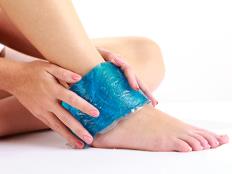5. Shin Splints
"Shin splints" refers to medial tibial stress syndrome, an achy pain that results when small tears occur in the muscles around your tibia (shin bone). This makes up about 15 percent of running injuries; 10 percent of runnersworld.com respondents poll had shinsplints in the past year.
WHO'S AT RISK?
Shinsplints are common among new runners and those returning after an extended layoff. They're a sign that you've done too much, too quickly, Dr. Price says. Shinsplints strike runners wearing the wrong shoe or a pair with too many miles, and those with high arches or flat feet.
CAN YOU RUN THROUGH IT?
When the first twinges of pain strike, back off your running to a comfortable level for a few days to a week, then slowly up your mileage using the 10 percent rule (no more than 10 percent increase per week). Bike, pool run, and swim.
REHAB IT
Rest, ice, and ibuprofen can ease the pain. Though conventional wisdom has preached calf stretching as a way to rehabilitate shinsplints, there's little evidence that helps, Price says. Taping the shin with Kinesio Tex tape can relieve pain and speed healing. (See how at runnersworld.com/shintape.) Wearing an air cast ankle brace throughout the day—even while running—can speed recovery. These braces stabilize the ankle so the shin muscles don't have to work so hard to support your leg, Saxena says.
PREVENT A RELAPSE
The easiest and best way to avoid shinsplints is to increase mileage gradually. Saxena also says to make sure you are in an appropriate shoe. Beginners, especially, can benefit from the professional help at a specialty running shop. If you have high arches, you may need a cushioned shoe. Or if you have flat feet, a rigid shoe might be the solution, he says.
ELITE TREATMENT
Once or twice a month, miler David Torrence jumps in a game of pickup basketball or soccer.
"The lateral movement uses your muscles differently than running in one direction," he says. "It's helped me manage my shinsplints."
Shin Signs: How to Proceed
Tenderness down the leg—especially if you hop on it. If even walking (not just running) hurts, it could be a fracture.
You experience a tight, aching pain when running—but the pain goes away when you stop. Hopping isn't painful.
When you are completely pain-free while running—even long after you stop applying ice after runs and taping your shins.
- 6
- of
- 8
Get ACTIVE on the Go


Couch to 5K®
The best way to get new runners off the couch and across the finish line of their first 5K.
Available for iOS | Android







Discuss This Article